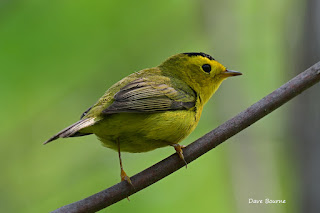The Blue-winged Warbler sings a distinctive bee-buzz from brushy fields. It dangles from branches and leaves, foraging like a chickadee but shows off bright warbler plumage: a yellow belly, yellow-olive back, and white wingbars across blue-gray wings.
A shrubland and old field specialist, it has benefited from landscape changes over the last 150 years as forest clearcuts and agricultural fields have grown up into scrubby fields. These changes have helped it expand northward, where it now hybridizes with and possibly threatens the much rarer Golden-winged Warbler. Cornell All About Birds

















